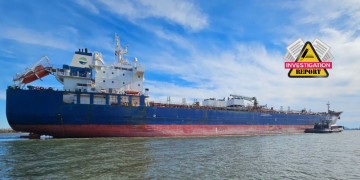In its latest Safety Flashes, IMCA examines two different cases of falls of crew members from step ladders which led to injuries. The two incidents highlight the need for proper risk assessments and routine inspections on ladders.
Incident #1
While climbing back down a ladder from the 3rd step/rung, a crewman lost his footing and fell backwards landing on the deck grating, hitting his head and jarring his neck.
Probable causes
- He did not check for safe securing of portable ladder;
- The uneven levelling of the deck was not considered prior to ladder use.
Incident #2
A forklift operator went up a step ladder to look at the top of container to ensure that there were no miscellaneous objects on top that could fall when the container was moved.
As he came down again, while he was over a metre off the deck, the ladder became unstable and he fell off and broke his wrist on landing, and suffered contusions on the left leg and left side of the body. This was an LTI (Lost Time Injury).
Probable causes
- No risk assessment, permit to work or procedure was in place for the task or for the lifting of the container;
- There had been no check of the ladder before he started going up it – otherwise he might have noticed it was damaged;
- The broken ladders shouldn’t have been there at all: there was no routine inspections of ladders, and no quarantining of defective ladders;
- He was not wearing safety boots at the time of the incident;
- There was no training or awareness methods in place for the safe use of ladders.
Lessons learned on ladder safety
Following report of the two incidents, IMCA stressed the need for:
- Risk assessment and toolbox talk before working on ladders;
- Routine inspection of ladders, and procedures that identify the quarantining of damaged ladders;
- Inspecting ladder before you start work
- Making sure you’re familiar with the hazards and risks before using a ladder;
- Positioning the ladder on a stable surface, where it won’t wobble.





























































